
Camalie Net has been in operation since 7/16/05 aiding irrigation decisions through two growing years. Based on the positive experience of using this technology in practice, work has accelerated to produce a second generation version with higher reliability and ease of use. We are also exploring the feasibility of productizing this technology.
Major steps forward recently include the following:
1. Crossbow's Xserve 2.1.11 for Linux was deployed enabling (a)web serving of health statistics, (b)logging of data to a local SQL database and (c) exporting of XML data streams to third parties over the web.
2. We moved to inexpensive full function Linux Gateway hosts using Xserve 2.1.11. Fedora Core 5 has emerged as the best form of Linux to use. The host laptops cost $400-500 and work with 512MB RAM and 40GB hard drives. An AMD Sempron 2800 running at 1.66GHz appears to meet all the requirements of Xserve. It is less clear whether these machines will be adequate to serve graphical analyses of the data. They are however more than adequate to store 5 years worth of vineyard data.
3. Found a software provider, Remtrol Inc., to capture the XML data streams from our gateway hosts and web serve graphs of the data. They accumulate our data remotely in their own database. Ironically Crossbow has no software capable of web serving data from their networks though they are close. Xserve does web serve health statistics derived from their networks. SensorSentry, the program developed by Remtrol is a full featured monitoring software suite. It includes configurable standard reports and alarms in addition to full function trend charts and data tables. However, it is showing signs of stress as the database grows. Plots of one sensor type for 15 motes over a two month period are taking about 30seconds to generate.
4. We transitioned a number of motes from mholler's mote firmware to the lastest revision of Xmesh 2.0. This has looked promising over short intervals but, still requires some proving over a longer time frame. With Xserve, the O.S., the host machines and the mesh firmware all changing at the same time some time to work out the bugs is required. The best result thus far has been a period of 13 days in November with 8-12 of the 14 motes reporting most of the time. This occurred from 11/12 to 11/25 using Xserve 2.1.11.
5. Conversions of raw ADC data to meaningful sensor readings in appropriate units using XML configuration files has become a reality. The modularization of the conversions into an easy to read XML file on the host has made conversion and calibration management much easier to accomplish. This is an innovation of Rahul Kapur at Crossbow.
There are now 3 completely independent wireless sensor networks in place at Camalie Vineyards each with its own purpose and set of hardware.
Camalie (433) Net
This network is the original network brought online in July of 2005 and used for irrigation decision making in 2005 and 2006. It runs at 433MHz on channel xxx_845. All of the motes in this network are mica2dots. I expect to retire this network as soon as the Crossbow 433 Network demonstrates consistent performance. The motes in this network can be moved to the Crossbow 433 network by a reprogramming their firmware. This network is the longest running with almost a year and a half online now with 12-20 motes running most of the time. The data base has grown to 150MB in its backup form. This database is now larger than Moteview can be used to view. This standard SQL database is a useful tool for testing alternative database and data analysis software. At this point we have no tools capable of presenting the data in this data base at adequate speeds. The data in this database is quite valuable for the grower because it contains two seasons of real data from multiple depths showing soil moisture levels and their response to irrigation actions. There are two years worth of grape yield and quality data for 6 different irrigation blocks associated with this soil moisture data.
Crossbow 433 Net
This is a network of 14 nodes which run one of the most recent versions of Crossbows Xmesh integrated with my sensor measurement firmware. This network is an alpha test site set up to stress test Xserve 2.0 and Xmesh. It first came online on 11/2/06. The motes operate on Channel 4 in the 433MHz band. Most of the motes in this network are mica2dots but three are mica2s, #s 15,14,25. These motes are transmitting at their maximum power, 10mW. This network is targeted to become the 2nd Generation Camalie Network and for use in making irrigation decisions for the 2007 growing season. It will also serve as a demonstration of Crossbow's most advanced technology. The host of this network is a Compaq laptop running Fedora Core 5 Linux connected to a Crossbow MIB520 gateway. Xserve 2.1.11 is currently running on this machine, serving health pages,CrossbowNet 433 logging data to an sqlite database and serving an XML data stream to a remote data analysis service at Remtrol inc. SensorSentry The longest test thus far has been 10 days.
Crossbow 916 Net
This is a small network set up recently to explore the viability of using 916MHz motes in the vineyard. This exploration is motivated by FCC limits on radiated field strength at 433MHz which will likely be difficult to meet. The focus of this network is to see at what ranges and power levels packets can be received consistently from motes in a real vineyard. Crossbow has demonstrated that a 916MHz mote operated at 1mW can meet FCC requirements without using frequency hopping. The tests were done by a third party.
This network was brought online on 12/20/06 and Remtrol started accumulating data from its XML output stream on 12/26/06. Antenna enhancements were made on the afternoon of 12/28/06 which improved range significantly. The network is operating at a 4mW power level at the moment. This network consists of motes 101,103,104 and 105 all in the field and dual AA battery powered. Health statistics are available at CrossbowNet 916 . SensorSentry includes data from the motes in this network as well. Ranges between motes are as follows:
Base to 101 70 ft.
101 to 103 110 ft.
103 to 104 200 ft.
104 to 105 540 ft.
Results are promising thus far but, reduction of the power level to 1mW is expected to reduce the range by 4X which may not be acceptable.
Here is the Mote Map as of 12/28/06.

Note: Nodes 15, 24 and 34 are all part of the Crossbow 433MHz network and are located in the attic of the garage with the servers and gateways.
Remtrol's participation in this project has been a pleasant surprise. You can access this program at http://www1.sensorsentry.com/login.asp to look at Camalie Vineyards real time data using username: CamalieGuest and password: Wireless.
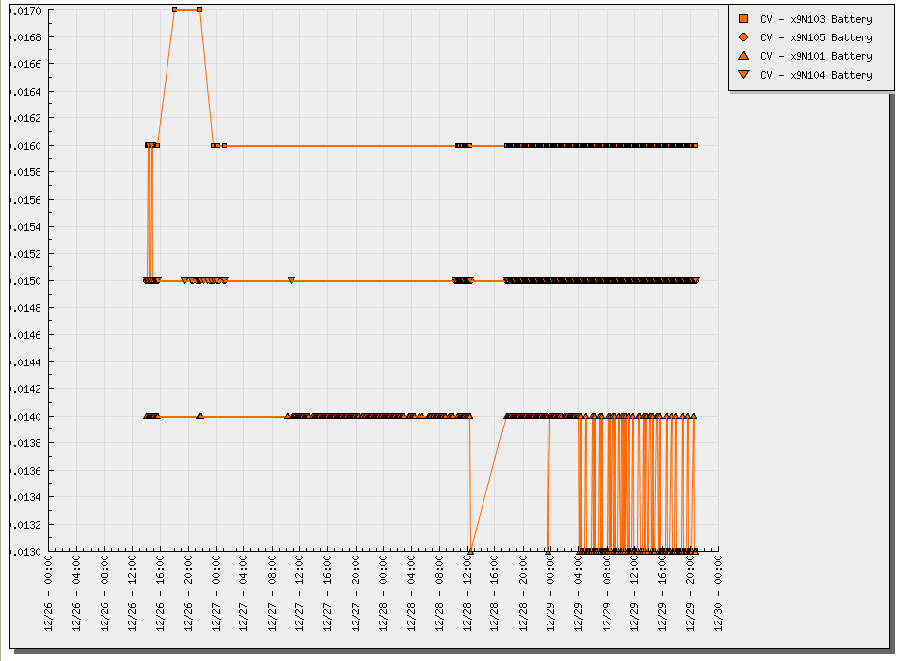
Graph courtesy of Remtrol Inc. Their product, SensorSentry, produced this graph.
Above is a graph of the 916MHz motes showing their performance from deployment. On the afternoon of 12/28 half wave antennas were installed to replace the stock quarter wave antennas. The half wave antennas were mounted to the tops of the Pelican 1010 boxes which allows them to stick up above the tops of the highway stakes which the boxes hang at the top of. The boxes were also wrapped in aluminum foil which contacts the grounded highway stakes. You can see that packet reception was much improved with these enhancements. Note that mote 105 is 540' from the nearest mote which is 104 indicating that the range is at least 540ft. in this configuration with 4mW power level set in the firmware.
Below are some pictures of the hardware and set up in the attic of the garage at Camalie Vineyards which is located where the circle labeled "GW" is shown on the vineyard map above. The internet connection has been upgraded to a Hughesnet DW7000 which provides 5 static IP addresses. The static IP addresses are used as follows:
72.168.166.82 Camalie Net
72.168.166.83 Crossbow Net 916MHz
72.168.166.86 Crossbow Net 433MHz
72.168.166.84 Web Cams and weather data,
72.168.166.85 Generic machine not serving.
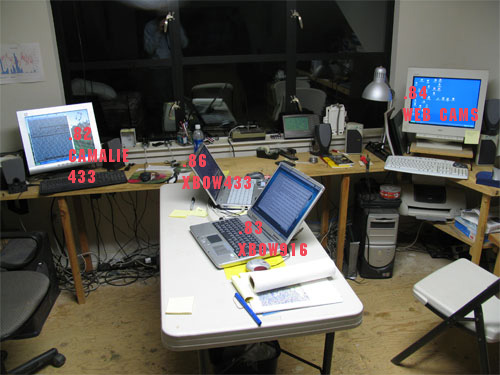
Above you can see all the servers. .82 and .84 are windows machines.
.83 and .86 are Fedora Core 5 Linux Laptops supporting the Crossbow networks.
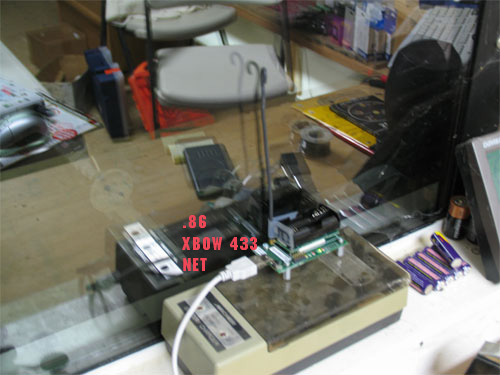
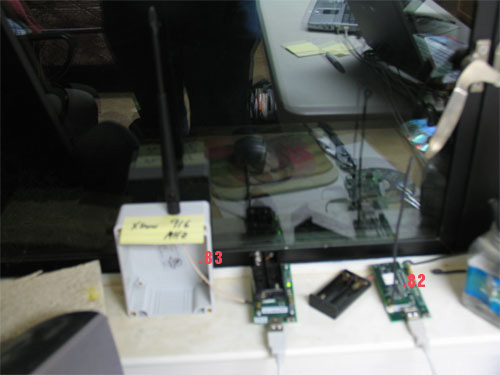
The Crossbow 916MHz network gateway using a halfwave antenna mounted to a plastic box to hold it upright. The 433MHz networks use quarter wave antennas.
Sorry for the poor focus pictures. The camera didn't know what to focus on with all the reflections.
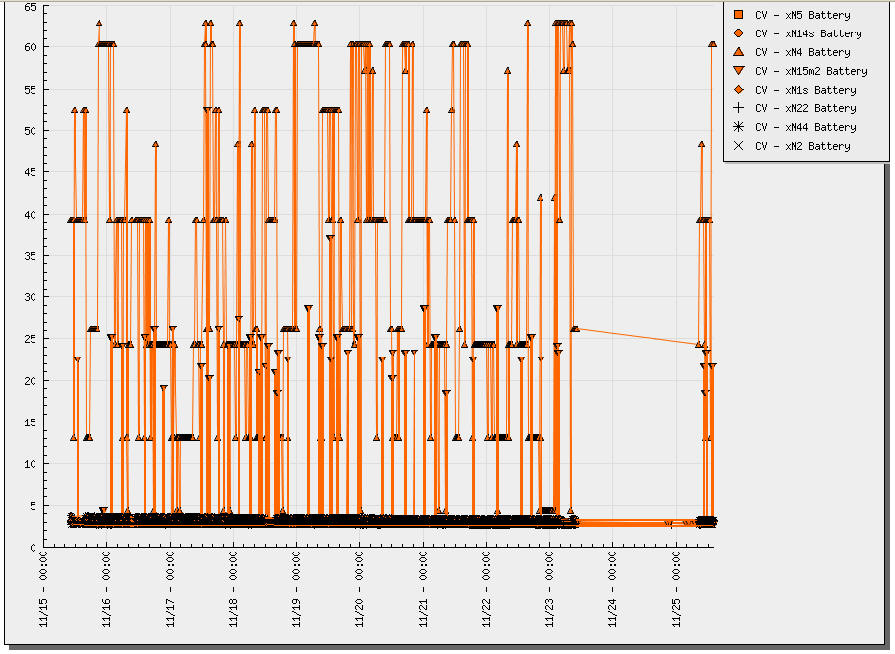
Above is a SensorSentry plot of the longest run of the Crossbow 433 network showing 8 motes running almost continuously for 10 days. The net actually started 3 days earlier but, Remtrol hadn't started capturing data from the XML stream yet. The gap around the 24th was due to Remtrol going down over the Thanksgiving Holiday. The spurious high battery voltages are due to conversion problems and a firmware problem on mote 4. These have since been fixed.
Last Updated 12/30/06 M.H.